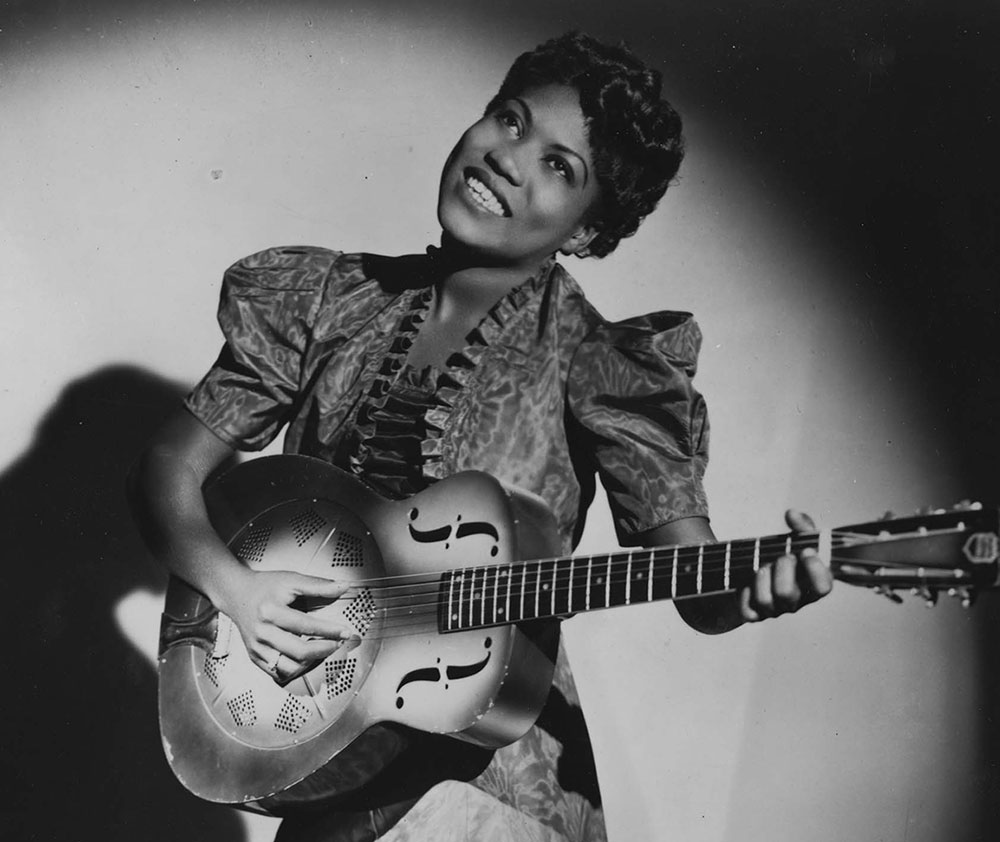Rockin' the Faith

Rock ‘n’ roll may not have been a bona fide musical genre until the 1950s, but a look back into history reveals that its roots lie in gospel and blues. When Elvis Presley was crowned the King of Rock ‘n’ Roll, it was because he embodied each of these musical stylings in a single performance. But before there was Presley (and Chuck Berry and Jerry Lee Lewis and The Beatles and The Rolling Stones), there was Sister Rosetta Tharpe, who formed the foundation of a sound that would soon have world all shook up.

Childhood
Tharpe was considered a musical prodigy as a young child. She played guitar and sang at services for the Church of God in Christ in Arkansas, where her mother Katie Bell Nubin was a singer, mandolin player and preacher. Beginning at age 4, she performed gospel music onstage with her mother, and the duo toured the South as part of an evangelical troupe. Their hybrid performance included sermons and spirituals.
Musical Breakthrough
Tharpe and Nubin moved to Chicago in the 1920s where the fusion of blues, jazz, swing and gospel formed a lively music scene. They performed at church services and conventions throughout the region. Tharpe garnered fame for her guitar playing and performance style, which blended traditional gospel music with secular rhythm and blues.
In 1938, Tharpe moved to New York City and signed with Decca Records to record the studio’s first-ever gospel songs. Her records “Rock Me,” “That’s All,” “The Man and I” and “The Lonesome Road” found immediate commercial success in their appeal to both religious and secular audiences. Tharpe quickly became a household name as a result.
-and-miche-braden-(sister-rosetta-tharpe)-photo-credit-roger-mastroianni56be08a5eccf68859297ff0000cc08a0.jpg?sfvrsn=5c716080_0&MaxWidth=800&MaxHeight=&ScaleUp=false&Quality=High&Method=ResizeFitToAreaArguments&Signature=FE46F1F645E70C950761C38E02E105AE623EC0ED)
Career Highlights
1938: Tharpe performed at Carnegie Hall in John Hammond’s Spirituals to Swing Concert and stirred up controversy with her performance. Conservative audiences disapproved of how she blended spirituals with swing and jazz, and some criticized her guitar playing since it was considered a traditionally male role.
1944: Tharpe was one of only two African-American gospel artists asked to record a V-Disc (“victory-disc”) for troops overseas during World War II. In the same year, Tharpe recorded “Strange Things Happening Every Day” and “Two Little Fishes and Five Loaves of Bread” with blues musician Sammy Price. The track combined piano, guitar and gospel. It became the first gospel hit on the Billboard R&B charts and peaked at No. 2.
1951: Tharpe married Russell Morrison at Griffith Stadium in Washington, DC. About 25,000 fans and audience members paid to attend the ceremony, which culminated in a joyous gospel performance and fireworks display.
-and-miche-braden-(sister-rosetta-tharpe)-photo-credit-roger-mastroianni-(2)6bbe08a5eccf68859297ff0000cc08a0.jpg?sfvrsn=77716080_0&MaxWidth=800&MaxHeight=&ScaleUp=false&Quality=High&Method=ResizeFitToAreaArguments&Signature=8A2656B74DA702C79F662282325D0D80D3017380)
Legacy
Shortly after her career peak in the early 1950s, Tharpe recorded a blues album that found little favor with her traditional audiences and it alienated her from her base. In her final years, she performed to smaller audiences throughout the country and went on a brief tour with Muddy Waters in Europe. She suffered considerable health setbacks in that time and passed away at the age of 58 in 1973. For her revolutionary contributions to the world of music, Tharpe is considered the founding mother and godmother of rock ‘n’ roll. Such icons as Little Richard, Chuck Berry, Elvis Presley, Jerry Lee Lewis, Johnny Cash, Jimi Hendrix and Eric Clapton have cited her as a major influence on not only themselves but on music as a whole. She will be inducted into the Rock & Roll Hall of Fame in April of 2018 with a special honor of the Award for Early Influence.
---------------------------------
The Impact of Sister Rosetta: A Celebration of Gospel, Blues, Rock and Jazz
Monday, March 12, from 7 - 8:30 p.m. at the Music Resource Center
Join us for a musical celebration of the cross-genre, multi-generational impact of Sister Rosetta Tharpe. Enjoy performances in her honor that trace the growth of gospel, blues, jazz and rock ‘n’ roll. This event will take place at the Music Resource Center located at 3032 Woodburn Ave., Cincinnati, Ohio 45206. It is free and open to the public but registration is required. Please call the Playhouse Box Office to reserve your spot at 513-421-3888.
To learn more about the Playhouse's production of Marie and Rosetta, visit our production detail page.